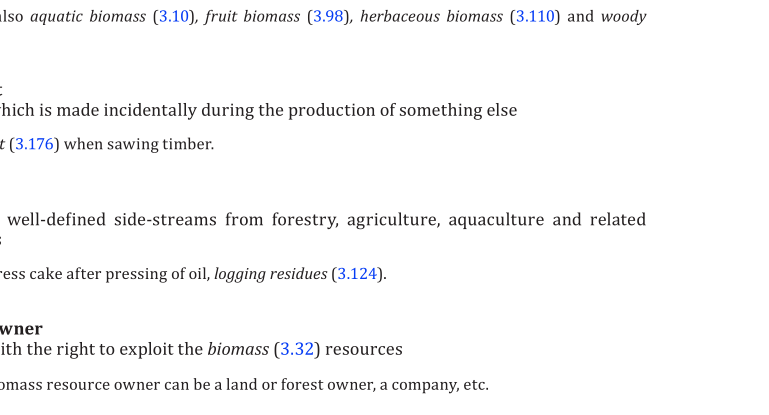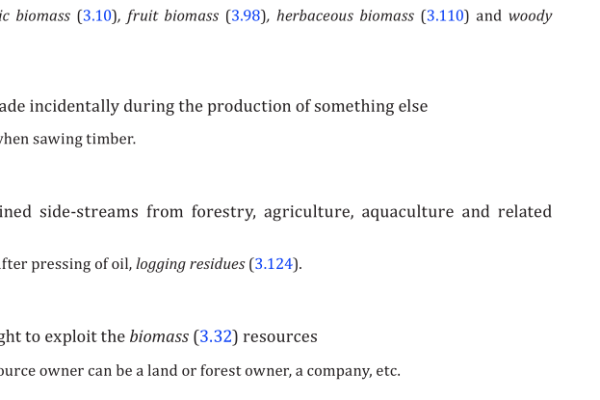ISO 16559:2022 pdf download – Solid biofuels — Vocabulary.
3.33 biomass by-product secondary product which is made incidentally during the production of something else EXAMPLE Sawdust (3.176) when sawing timber. 3.34 biomass residue biomass (3.32) from well-defined side-streams from forestry, agriculture, aquaculture and related industrial operations EXAMPLE Olive press cake after pressing of oil, logging residues (3.124). 3.35 biomass resource owner body or enterprise with the right to exploit the biomass (3.32) resources Note 1 to entry: The biomass resource owner can be a land or forest owner, a company, etc. 3.36 biomethane methane produced from biomass (3.32), e.g. solid biofuels (3.185) Note 1 to entry: Biomethane is not a solid biofuel (3.185). The term is included for information only. 3.37 biosludge sludge formed in the aeration basin during biological waste water treatment or biological treatment process and separated by sedimentation or flotation Note 1 to entry: Biosludge must be treated for the transformation into solid biomass (3.32). 3.38 black liquor fluid containing lignin (3.121) removed from the wood in the pulping process Note 1 to entry: Black liquor also contains pulping chemicals. Note 2 to entry: Black liquor is not a solid biofuel (3.185). The term is included for information only. 3.39 bridging arching tendency of particles (3.147) to form a stable arch across an opening which restricts flow [SOURCE: ISO 21637:2020, 3.8, modified — “bridge” replaced by “arch”.] 3.40 bulk density BD mass of a portion of a particulate matter divided by the volume (3.214) of the container which is filled by that portion under specific conditions [SOURCE: ISO 21637:2020, 3.9, modified — abbreviation “BD” added, “solid fuel” replaced by “particulate matter”, text in parentheses deleted.]
3.41 bulk permeability permeability in storage ability of gas such as air to pass through the void spaces in biomass (3.32) during storage Note 1 to entry: Permeability is measured in pressure (Pa) vs. flow of gas (m 3 /s/m 2 ) and depends for example on the viscosity and density (3.65) of the gas (including moisture content (3.132) and temperature), shape, and orientation of particles (3.147) and the bulk porosity of biomass (3.32). 3.42 bundled biofuel bundle solid biofuels (3.185) which have been bound together and where there is a lengthwise orientation of the material EXAMPLE Bundles of short rotation coppice (3.178), logging residues (3.124) or small trees. 3.43 calorific? value heating value Q energy amount per unit mass released on complete combustion Note 1 to entry: Q is used as designation for the net calorific value (3.136) as received (3.12) basis at constant pressure (q p,net,ar ). Note 2 to entry: See also gross calorific value (3.106), energy density (3.77), net calorific value (3.136). 3.44 cereal crops annual crops grown with the main purpose of using the seed for food production EXAMPLE Barley, wheat, rye, oat. Note 1 to entry: Some cereal crops can be used as a solid biofuel (3.185). 3.45 certified? reference? material CRM reference material (3.164) of which one or more property values are certified by a technically valid procedure, accompanied by or traceable to a certificate or other documentation which is issued by a certifying body 3.46 charcoal biochar biocarbon biocoke biocoal solid biofuel (3.185) derived from carbonization, distillation or pyrolysis of biomass (3.32) [SOURCE: ANSI/ASABE S593] 3.47 chemical treatment any treatment with chemicals other than air, water or heat [SOURCE: ISO 17225-1:2021, 3.1, modified — Note 1 to entry deleted.] 3.48 chopped straw straw which has been cut into small pieces
ISO 16559:2022 pdf download – Solid biofuels — Vocabulary






